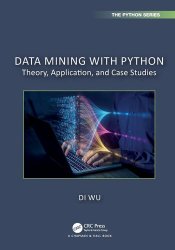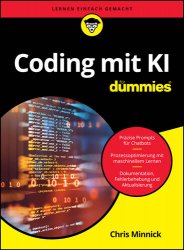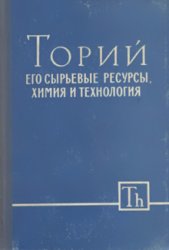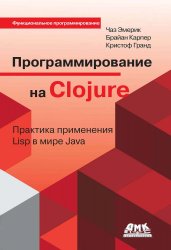 Название: Data Mining with Python: Theory, Application, and Case Studies
Название: Data Mining with Python: Theory, Application, and Case StudiesАвтор: Di Wu
Издательство: CRC Press
Серия: The Python Series
Год: 2024
Страниц: 415
Язык: английский
Формат: pdf (true)
Размер: 13.8 MB
Data is everywhere and it’s growing at an unprecedented rate. But making sense of all that data is a challenge. Data Mining is the process of discovering patterns and knowledge from large data sets, and Data Mining with Python focuses on the hands-on approach to learning Data Mining. It showcases how to use Python Packages to fulfill the Data Mining pipeline, which is to collect, integrate, manipulate, clean, process, organize, and analyze data for knowledge.
The contents are organized based on the Data Mining pipeline, so readers can naturally progress step by step through the process. Topics, methods, and tools are explained in three aspects: “What it is” as a theoretical background, “why we need it” as an application orientation, and “how we do it” as a case study.
Data collection is a crucial step in the process of obtaining valuable insights and making informed decisions. In today’s interconnected world, data can be found in a multitude of sources, ranging from traditional files such as .csv, .html, .txt, .xlsx, .html, and .json, to databases powered by SQL, websites hosting relevant information, and APIs (Application Programming Interfaces) offered by companies. To efficiently gather data from these diverse sources, various tools can be employed. Python offers a rich ecosystem of packages for data collection. Some commonly used Python packages for data collection include: including:
• Pandas: Pandas is a powerful library for data manipulation and analysis. It provides data structures and functions to efficiently work with structured data, making it suitable for data collection from CSV files, Excel spreadsheets, and SQL databases.
• BeautifulSoup: Beautiful Soup is a Python library for web scraping. It helps parse HTML and XML documents, making it useful for extracting data from
websites.
• Requests: Requests is a versatile library for making HTTP requests. It simplifies the process of interacting with web services and APIs, allowing data retrieval from various sources.
• mysql-connector-python, psycopg2, and sqlite3: These libraries are Python connectors for MySQL, PostgreSQL, and sqlite databases, respectively. They enable data collection by establishing connections to these databases, executing queries, and retrieving data.
• Yahoo Finance: The Yahoo Finance library provides an interface to access financial data from Yahoo Finance. It allows you to fetch historical stock prices, company information, and other financial data.
These are just a few examples of Python packages commonly used for data collection. We will cover them in detail with tutorials and case studies. Depending on the specific data sources and requirements, there are many more packages available to facilitate data collection in Python.
Data Visualization is the process of creating graphical representations of data in order to communicate information and insights effectively. The goal is to use visual elements such as charts, plots, and maps to make the data more accessible, understandable, and actionable for different audiences. There are several Python packages that are commonly used for data visualization, including:
• Pandas: It integrates with other libraries such as Matplotlib and Seaborn that allow to generate various types of plots and visualizations, that can help understand the data and, identify patterns and trends.
• Matplotlib: It is a 2D plotting library that provides a wide range of tools for creating static, animated, and interactive visualizations. It is widely used as the foundation for other libraries.
• Seaborn: It is a library built on top of Matplotlib that provides a higher-level interface for creating more attractive and informative statistical graphics. It is particularly useful for data visualization in statistics and Data Science.
• Plotly: It is a library for creating interactive and web-based visualizations and provides a wide range of tools for creating plots, maps, and dashboards. It is particularly useful for creating interactive visualizations that can be embedded in web pages or apps.
• PyViz: It is a library that is composed of a set of libraries such as Holoviews, Geoviews, Datashader and more, for creating visualizations for complex data and large datasets.
In the field of Machine Learning and pattern recognition, Nearest Neighbor Classifiers are fundamental algorithms that leverage the proximity of data points to make predictions or classifications. This section introduces two essential Nearest Neighbor Classifiers, K-Nearest Neighbors (KNN) and Radius Neighbors (RNN), and demonstrates their practical implementation using the Scikit-learn package. K-Nearest Neighbors (KNN) is a supervised machine learning algorithm used for classification and regression tasks. It operates on the principle that data points with similar features tend to belong to the same class or category. Throughout this section, you will explore the KNN algorithm’s core concepts and practical implementation using Scikit-learn. Radius Neighbors (RNN) is an extension of the KNN algorithm that focuses on data points within a specific radius or distance from a query point. This approach is useful when you want to identify data points that are similar to a given reference point. Within this section, you will delve into the RNN algorithm’s fundamental concepts and practical implementation using Scikit-learn.
This book is designed to give students, data scientists, and business analysts an understanding of Data Mining concepts in an applicable way. Through interactive tutorials that can be run, modified, and used for a more comprehensive learning experience, this book will help its readers to gain practical skills to implement Data Mining techniques in their work.
Скачать Data Mining with Python: Theory, Application, and Case Studies
[related-news] [/related-news]
Комментарии 0
Комментариев пока нет. Стань первым!















